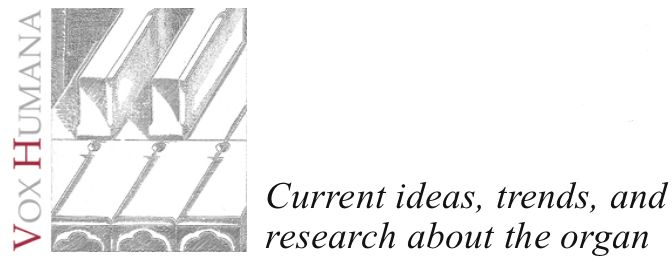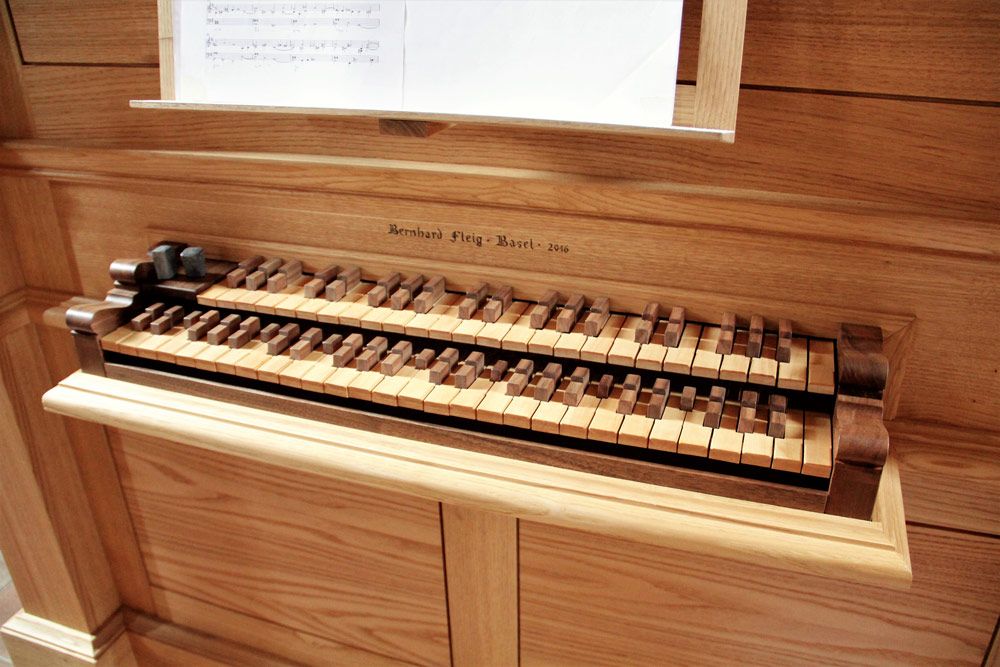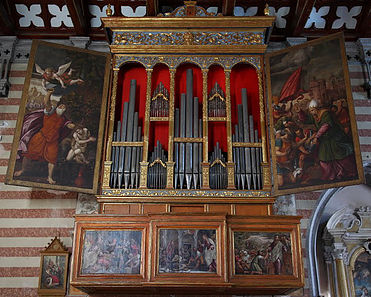


April 8, 2018
JOHANNES KELLER & CASPAR JOHANNES WALTER
–––––––––––––––––––––––––––
36 Keys per Octave: The Arciorgano

April 8, 2018
JOHANNES KELLER & CASPAR JOHANNES WALTER
–––––––––––––––––––––––––––
36 Keys per Octave: The Arciorgano

Introduction from the Editor
Since the invention of the keyboard, instrument builders, composers, and theorists alike have struggled with how exactly to divide the interval of an octave. Today most modern organs and pianos are tuned in a system called equal temperament, in which the octave is divided equally into 12 different pitches. However, this means that most intervals in equal temperament are quite far from being mathematically pure; we don’t notice this because we have been hearing keyboard instruments tuned in equal temperament since we were children.
In the early medieval period, the most common tuning was Pythagorean, in which fifths are mathematically pure. However, in the late medieval period/early Renaissance, tastes in music began to change, and the interval of a third came into favor. The problem is that, if one begins on C and tunes four mathematically pure fifths in a row upwards, the resulting E will sound extremely dissonant. To correct this, instrument builders narrowed (lowered) the fifth by a division of an interval called the syntonic comma (which equals 21.50 cents; for reference, in equal temperament, there are 100 cents between each half step —these are really tiny changes that make a huge difference!).
The most common temperament during the sixteenth and seventeenth centuries is called quarter-comma meantone, in which the interval of a fifth is flattened by a quarter of a syntonic comma, or 5.377 cents.

While narrowing fifths by a portion of the syntonic comma solves some problems, it creates others. In quarter-comma meantone, about the first half of the circle of fifths (C major, D major, etc.) contain pure thirds; however, this means that more remote keys like F-sharp major are completely unplayable. This is because in meantone, each black key has only one unique function (i.e. the F-sharp key cannot also function as a G-flat like in equal temperament). To demonstrate this, here is a recording of major triads proceeding around the wheel of fifths played on a meantone organ, (i.e. a C major triad followed by G major, D major, etc.):

Researchers at Studio 31, based at the Schola Cantorum Basiliensis and the Musik-Akademie in Basel, Switzerland have found historical evidence from the sixteenth century of an instrument that posed another solution to the problem of how to divide an octave, which has profound implications for the performance of early music, as well as extraordinary possibilities for contemporary music. The 2016 reconstruction of an arciorgano by Bernhard Fleig and a symposium that took place in Basel in November 2017 is the culmination of their research thus far, but they’ve only scratched the surface.
To start, here’s a video of the arciorgano:
Nicola Vicentino: Madonna il poco dolce, performed by Johannes Keller on the 2016 arciorgano by Bernhard Fleig at the Schola Cantorum Basiliensis in Basel, Switzerland.
––––––––––––––––––––––––
Professors Keller and Walter, thank you for agreeing to this interview. What is an arciorgano?

Johannes Keller: It’s a pipe organ based on descriptions from Nicola Vicentino’s 1555 treatise, L’antica musica ridotta alla prattica moderna ["Ancient Music Condensed to Modern Practice"]. He wrote L’antica musica before organizing the building of an arciorgano. However, he did already have an archicembalo the same keyboard design as the arciorgano, and in 1561, there was an advertisement he had printed that described the arciorgano in great detail. These two texts were the primary sources for the reconstruction of this arciorgano.

How is the keyboard laid out?

For every key on the lower manual, a fifth above it on the upper manual will be pure. In practice, that means that if I wanted a pure D major chord, I would play D and F-sharp on the lower keyboard (which is already pure due to the quarter-comma meantone system). However, in quarter-comma meantone, the interval of a fifth (between D and A) is flat by a quarter comma; since the upper keyboard is tuned a quarter comma higher, I would play the A(+) on the upper keyboard.

The same is true for minor thirds; in meantone, they are a smaller interval than pure. To play a D minor chord in just intonation, I would play the D on the lower manual, and the F(+) and A(+) on the upper. Thus, I can play any triad starting with a root on the lower manual in just intonation. Vicentino describes the arciorgano as an instrument that contains all perfect consonances, that can achieve the sound properties of just intonation without the problem of the syntonic comma. To sum it up, one could say that it sounds like just intonation, but without having to deal with the syntonic comma.
How was the arciorgano conceived? Is this the first arciorgano that was ever built, or were there instruments in the seventeenth century that were lost?

No original arciorgano survives. The only one that comes close to it is a clavemusicum omnitonum built in 1606 by Vito Trasuntino in Venice. It’s not playable, but it is complete as an object, and has 31 keys per octave in a similar arrangement. This is the only instrument that is comparable in its complexity to Vicentino’s instruments.

We know that Vicentino had several arciorgani and archicembali built; the first arciorgano was built by Vincenzo Colombi, who also built instruments for important places like the Basilica di San Marco in Venice. He also built a major instrument at the Duomo of Valvasone, which is still playable. With such a high-profile builder involved, the arciorgano was clearly not just an experiment, but really a working musical instrument. There is even evidence that Vicentino had four or even five arcirogani built, and at least two archicembali.


How did this reconstruction come to be, and what design challenges did you face in the process?
Vicentino describes many technical aspects of the arciorgano quite precisely. For example, number of individual pipes, the number of rows of pipes, the shape of the pipes, their arrangement, the length of the longest pipe, and the keyboard design that even includes a scale drawing. With so much already given, there really wasn’t all that much left to design. The only thing that we had to invent from scratch was the key action. The treatise doesn’t include any mention of a rollerboard or any type of mechanisms used; it just says that “it’s beautiful to look at.”
Through drawings, we explored different options with our builder, Bernhard Fleig. We decided to go with a double windchest that has a rollerboard in front, and a second in back, with two sets of palates in one windchest.
What were the arciorgano's uses in the seventeenth century, and what can it teach us now?
Vicentino himself apparently wrote quite a lot of music specifically for these kinds of instruments, but the one printed book that he mentions having pieces using different harmonic notes is lost. But there are some fragments in the treatises.
As to their use beyond those works, my thesis is that perhaps they were used as a tool for composing and tuning chromatic madrigals and other tonally-complex polyphony. Carlo Gesualdo himself owned a cimbalo cromatico (which has 19 keys per octave). We know that Luzzasco Luzzaschi played Vicentino’s archicembalo. Michelangelo Rossi also had access to Vicentino’s instruments in Rome. I think it’s safe to say that the presence of these instruments triggered a certain imagination for the exploration of the previously-impossible regions of the tonal system. You can find that most impressively in the madrigal literature. I argue, then, that whenever preparing madrigals that use more than 12 pitches per octave, you should use these instruments as a reference point, and for rehearsals:
Nicola Vicentino: The begining of Madonna il poco dolce sung four times, each with different chromatic alteration. Performed by Ensemble Domus Artis accompanied by Johannes Keller on the 2016 arciorgano by Bernhard Fleig at the Schola Cantorum Basiliensis in Basel, Switzerland.
The decision whether to use the arciorgano in performance is at the discretion of the artists, influenced primarily by the context of the performance. But simply using it as a reference model for the education of singers, and for an organist’s own imagination of how pure tuning should sound, is very important and historically accurate.
Caspar Johannes Walter: If you see A-flat and G-sharp in an Italian chromatic piece from this period (or something more complex), it may have been conceived on these instruments. It’s also important to understand that with so many divisions of the octave, it’s possible to move from a conventional key to a remote one very quickly, which is something that was done and discussed among composers of that time (like Gesualdo).
Johannes Keller: I think that this instrument’s main job historically is to better chromatic madrigals. It’s very efficient, and artistically it makes sense to use it, at least the 19-keys-per-octave system of the cimbalo cromatico. But the historical role of the adapted just intonation system is more of an extreme experiment to show the limits of certain systems and to push the boundaries even further, but it was never used widely.
Caspar Johannes Walter: It's a cyclic system, and so in contemporary music, you can find the smallest interval (e.g. between C-sharp and D-flat), and you can transpose to any constellation of chords; for example, with this instrument, you could have a G-flat major chord that is in just intonation, and then move to E-flat minor, and it sounds normal. Additionally, adapted just intonation makes it possible to create colors through modifying the “beats” between notes.
Another interval that is particularly beautiful in adapted just intonation is the natural seventh, whose tuning in this system corresponds as a mathematically pure interval in the harmonic series. All this translates to the possibility of absolute clarity that results from truly playing in just intonation at the keyboard.
One could also develop things like hyperchromatic lines with polyphonic voice leadings, so that the changes in pitch are so fine that they are almost imperceptible.
So it’s possible to play most any piece in something close to just intonation?
Johannes Keller: Yes, it’s possible to play any kind of consonant polyphony on this keyboard. You don’t need any special notation, only to be familiar with the finger mechanics of navigating 36 keys per octave! I actually got to the point where, in my scores, I've stopped writing which keys and manuals I should play because it’s actually safer for me now to just think of the precise intervals themselves while I’m playing. It’s sort of like realizing a figured bass line; at first you play from a written out realization, but after a while you reach a point where it’s simpler (and you’re more flexible) to improvise the realization in real time. I think it’s a similar case on the arciorgano.
How do you tune an organ with 36 pipes per octave, and how long does it take?
We don’t, actually. This instrument is an organo di legno — an open principal made of wood, which is cut to precisely the right pitch. We decided against devices like tuning slides or flaps because they’re not historically accurate, and we observed that adding any of these devices decreased the quality of the sound of the pipe.
Caspar Johannes Walter: When it gets colder or warmer, the entire pitch of the organ moves up or down, but the intervals basically stay completely in tune.
Johannes Keller: The tuning process during the building was very intense and complex, and we had to decide what we were going for before we began — once you cut an open pipe like that, there’s no going back. We spent about 30 hours over the course of 10 days, and I learned a tremendous amount about tuning and sound. You really approach a limit of perception. We tuned as many pure intervals in a row as we could; in a conglomerate of exclusively pure intervals, you can find the tiniest error. We found that we actually couldn’t use electronic tuning devices anymore because our ears were more precise. Now the tuning is very stable (which was also part of the experiment of this instrument).
You also have a clavemusicum omnitonum and an archicembalo at Studio 31. How has that affected your research?
They are much more flexible than the organ, in terms of experimenting with modified temperaments. We actually used them to test the concepts of adaptive just intonation and other systems before we tuned the organ. In practice, we use the clavemusicum omnitonum in addition to or as an alternative to the arciorgano. It’s very interesting for us to hear the sound possibilities next to each other, for both timbre and intonation.
Caspar Johannes Walter: With contemporary music, we can also do experiments much faster with the harpsichords, and we can use multiple instruments at the same time to create even more pitches.
Johannes Keller: Combining them, once we actually created 53 pitches per octave.
Caspar Johannes Walter: It can take up to an hour to tune these instruments for such extreme experiments!
Do you have any forthcoming publications about these instruments and your research?
Johannes Keller: We do have quite a lot online already. Caspar Johannes has a tool on his website where you can experiment with a virtual arciorgano. There will be quite a few papers coming out on it in the next few years by me, Johannes Walter, and Martin Kirnbauer [the third leader of Studio 31]. There will also be a book about the symposium that took place in Basel on November 24–25, 2017. We will have a professional recording made by the end of 2019, but with so many possibilities using these instruments, we’re still not sure what we want to record first.
Caspar Johannes Walter: We do sessions where interested composers can see and work with the instruments, but it takes many steps to really understand these complicated systems. It will probably take a few years before we can really be able to present bigger compositions. Right now, we’re writing small pieces, mostly studies.
Johannes Keller: We also have a newsletter subscription (in German), where you can follow all our progress on Studio 31. We welcome scholars and researchers to come and visit the instruments as well, and we think there will be some really great music coming from these instruments in the future.
––––––––––––––––––––––––
The views and opinions expressed in this article are those of the author, and do not necessarily reflect the position of Vox Humana.